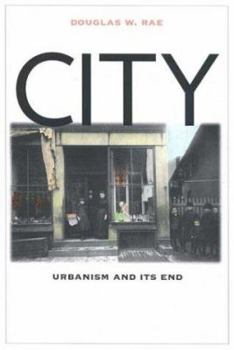City: Urbanism and Its End
(Part of the The Institution for Social and Policy Studies Series)
Select Format
Select Condition 
Book Overview
A new understanding of the modern city, its challenges, and why old ideas about urban renewal won't work How did neighborhood groceries, parish halls, factories, and even saloons contribute more to... This description may be from another edition of this product.
Format:Hardcover
Language:English
ISBN:0300095775
ISBN13:9780300095777
Release Date:October 2003
Publisher:Yale University Press
Length:516 Pages
Weight:2.13 lbs.
Dimensions:1.7" x 6.6" x 9.7"
Customer Reviews
4 ratings
a case study of a city's rise and fall
Published by Thriftbooks.com User , 19 years ago
Many books have been written about the decline of American cities- but I have found none quite like this one. Rae's book is not an abstract set of generalizations, but a case study of one city: New Haven, Connecticut. The first half of the book begins by talking about the rise of New Haven. At the start of the 19th century, New Haven was just one of many small towns in south central Connecticut. But by 1910 it was an industrial powerhouse with 80% of the region's population. What went right? Once railroads were invented in the early 19th century, intercity (between cities) transportation became much easier - but at the same time, intracity transportation was still cumbersome. So industry was centralized in a few downtowns, and most people lived within a mile of their work. And cheap energy (through coal and steam) benefited port cities which, like New Haven, lacked the power of falling water and thus did not have a large mill industry. Moreover, coal (unlike modern electricity) was also easier to transport between downtowns than within cities. So labor and capital were centralized in New Haven, which by 1910 was a crime-free, bustling, very urban place. New Haven stopped growing as early as the 1920s, and started to shrink in the 1950s. What went wrong? Rae lists a variety of factors- some that were beyond the control of any politician, and some that could have been controlled through more enlightened public policy. In the first category, Rae mentions the rise of the automobile (which decentralized regions by making transportation within a region easier) and the rise of the electric power grid (which allowed cheap energy to go beyond regional cores). Television decimated the city's volunteer civic organizations, and national centralization of industry meant that local groceries were supplanted by regional supermarkets and New Haven's industries were bought by corporations headquartered in other cities and often moved around the country or around the globe. In the second category, Rae criticizes highways that encouraged movement to suburbia, public housing projects that anchored low-skill people in urban cores that were losing low-skill manufacturing jobs, zoning that discouraged retail outside of a few commercial streets, New Deal housing agencies that discouraged investment in urban working-class neighborhoods, and urban renewal projects that bulldozed those neighborhoods in the 1950s and 1960s to build more highways and housing projects. Was sprawl inevitable? Given the wide range of factors cited by Rae, some sprawl was inevitable- but the disastrous decline of New Haven probably wasn't.
Exceptional and Entertaining
Published by Thriftbooks.com User , 21 years ago
I found this to be an absorbing, detailed, and provocative political and social history of New Haven, with lessons and delightful insights for those interested in the future of our cities, suburbs, and communities. Only a well-respected Yale political scientist like Doug Rae, with the sophistication of someone who has experienced firsthand how policy and implementation collide, could have written as entertaining and perceptive a history. The book is an immense public service, and required reading for those interested in urban planning, redevelopment, and public policy. I enjoyed it thoroughly!
Tour de force shatters urban legends
Published by Thriftbooks.com User , 21 years ago
Rae spins a story like a novelist, but this book is really a tour de force, assembling an impressive amount of data to explain how well-intentioned urban planning policies failed, and how America lost its sense of what creates livable cities. It's a terrific read for anyone interested in the tale of American urban evolution in the twentieth century, and a must-read for those involved in urban planning, public policy and politics.
Simply the best book on cities.
Published by Thriftbooks.com User , 21 years ago
This book chronicles the rich urban life of New Haven, CT, and the forces that brought about its decline in the postwar period. It dissects the misplaced theories underpinning the urban renewal movement and details the disastrous effects that these policies had on New Haven. While the book focuses on New Haven, the discussion is pertinent to urban renewal projects in dozens of US cities, and is of interest to anyone interested in the decline, and possible rebirth of urban life. One unique characteristic of this book is the quality of the writing: witty, insightful. Despite being a scholarly book, it reads like a novel. I would highly recommend this book to anyone interested in cities.





